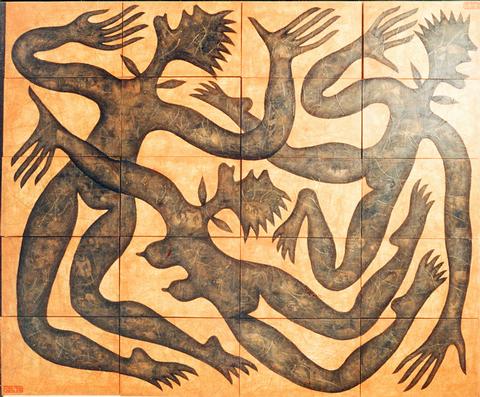This work was titled `Yellow River' in China, but I called it `Tamshui River' here. It was called by some other river's name when exhibited in Germany," said Chinese artist Ren Rong
Easily adapting the titles of his works to suit any country, the Bonn/Beijing-based artist views Ren Rong, his second touring exhibition since 1999, as a cultural exchange between countries. Titling the exhibition after himself, Ren had brought this "record of my life, people I had contact with and places I visited" to six cities in Germany before coming to Taipei. It will be heading for Taichung's Stock 20 in July before moving on to Hong Kong, Beijing, Jerusalem and more German cities.
River consists of 80 small-format paper cuts mounted on cardboard surfaces. They were in a flowing linear formation meandering across an entire wall in the gallery.

These black paper cuts are of "plant people"
The origin of the creature goes back to Ren's pre-college days. "I used to love painting human nudes. The human body's natural texture had great appeal for me. When placed in nature or among plants, it blends in with perfect harmony," Ren said in an telephone interview with the Taipei Times.
After college, it occurred to Ren to blend natural and human nudes into one creature, which, according to Ren, is ever-growing and freely reproducing.

PHOTOS COURTESY OF REN RONG
The fact that "plant people" means the "brain-dead" in Taiwan has been a constant joke among Ren's Taiwanese friends. "I invented the phrase in German. `Pflanzenmenschen' is a poetic word. For me, it represents the `ultimate exercise' -- constant movement, transformation and growth. Plant people are by no means stationary," Ren said.
These spiky-head plant people wear a hard-working expression. Their limbs strenuously stretch out and sometimes entwine with other plant people. The effect of exertion is further enhanced by their extending fingers and toes that seem to be reaching out to grab something.
The background cardboard is a collage of comics, maps, newspaper clippings and calligraphy in Chinese and German, which Ren has been collecting since he moved to Germany in 1986.
"Ren's popularity in Germany is due more than a little to the Oriental, or exotic, appeal of his paper-cuts," said Weng Suying (翁淑英), promotion chief at Hong-Gah. "The contrasting color scheme of red and black and the simplified human forms similar to traditional Chinese New Year decorations create a typical Chinese style," Weng said, referring to Ren's Positive and Negative, a collage of 200 paper cut plates. The Negative part is also on show at Hong-Gah.
For the Taiwan show, Ren made people plant people -- six new large paper-cuts on cardboard.
One of the series shows three plant people seemingly halfway in their stunt with details from an ancient painting Fire Mountain in Xinjiang in the background. Ren's photo portraits are densely superimposed on the silhouettes. Beeswax is sprayed on the bright earth-toned paper to create a warm texture. The vitality of the work seems to reach out from the paper.
"I was born under the element of fire. That fire mountain has special meaning for me. So it figures in my works. That's how I create works. My life and my work are one," Ren said, explaining the creative process of the works which are more like his diaries.

This month the government ordered a one-year block of Xiaohongshu (小紅書) or Rednote, a Chinese social media platform with more than 3 million users in Taiwan. The government pointed to widespread fraud activity on the platform, along with cybersecurity failures. Officials said that they had reached out to the company and asked it to change. However, they received no response. The pro-China parties, the Chinese Nationalist Party (KMT) and Taiwan People’s Party (TPP), immediately swung into action, denouncing the ban as an attack on free speech. This “free speech” claim was then echoed by the People’s Republic of China (PRC),

Exceptions to the rule are sometimes revealing. For a brief few years, there was an emerging ideological split between the Democratic Progressive Party (DPP) and Chinese Nationalist Party (KMT) that appeared to be pushing the DPP in a direction that would be considered more liberal, and the KMT more conservative. In the previous column, “The KMT-DPP’s bureaucrat-led developmental state” (Dec. 11, page 12), we examined how Taiwan’s democratic system developed, and how both the two main parties largely accepted a similar consensus on how Taiwan should be run domestically and did not split along the left-right lines more familiar in

Specialty sandwiches loaded with the contents of an entire charcuterie board, overflowing with sauces, creams and all manner of creative add-ons, is perhaps one of the biggest global food trends of this year. From London to New York, lines form down the block for mortadella, burrata, pistachio and more stuffed between slices of fresh sourdough, rye or focaccia. To try the trend in Taipei, Munchies Mafia is for sure the spot — could this be the best sandwich in town? Carlos from Spain and Sergio from Mexico opened this spot just seven months ago. The two met working in the

Many people in Taiwan first learned about universal basic income (UBI) — the idea that the government should provide regular, no-strings-attached payments to each citizen — in 2019. While seeking the Democratic nomination for the 2020 US presidential election, Andrew Yang, a politician of Taiwanese descent, said that, if elected, he’d institute a UBI of US$1,000 per month to “get the economic boot off of people’s throats, allowing them to lift their heads up, breathe, and get excited for the future.” His campaign petered out, but the concept of UBI hasn’t gone away. Throughout the industrialized world, there are fears that